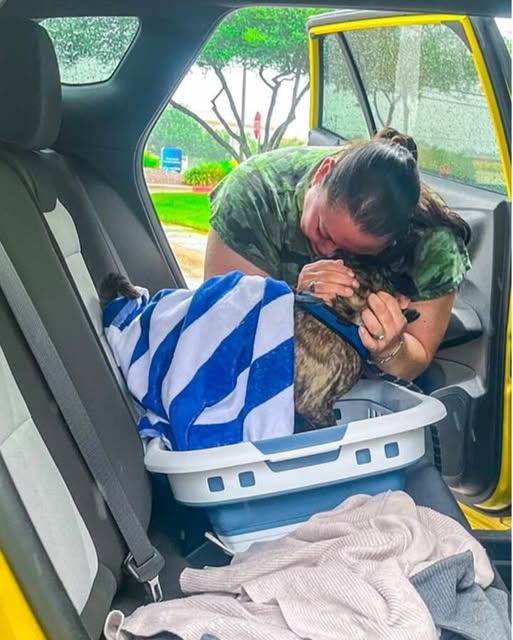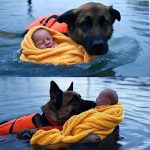A Miracle After the Storm: Blue’s 8-Year Journey Home and the Power of Enduring Love

A Miracle After the Storm: Blue’s 8-Year Journey Home and the Power of Enduring Love
In the chaotic aftermath of Hurricane Harvey, one of the most devastating storms to hit Texas in 2017, countless families faced unimaginable loss—homes destroyed, lives upended, and loved ones separated. For one family in Corpus Christi, the hurricane’s fury didn’t just tear down fences; it stole away their beloved 2-year-old dog, Blue. As floodwaters rose and winds howled, Blue vanished without a trace, slipping through the broken barrier in her backyard. Her family searched tirelessly—posting flyers, scouring neighborhoods, and calling shelters—but hope faded as days turned to weeks, then months, and eventually years. They waited, hoped, and grieved, never fully letting go but accepting the painful reality that Blue might be gone forever. Eight long years passed, marked by anniversaries of the storm and quiet remembrances of their furry companion.
Then, in a twist that seems straight out of a Hollywood script, last week in July 2025, over 300 miles away in Waco, Texas, a good Samaritan discovered a quiet, weathered dog huddled in a public restroom at Cameron Park. The dog was alone, showing signs of a hard life—matted fur, weary eyes, but still gentle and trusting. Brought to the Pet Circle Regional Animal Center, staff followed routine protocol: scanning for a microchip, as they do for every stray. To their astonishment, the chip was intact, its data still accurate after nearly a decade. The contact information led straight back to Blue’s original family. Everything changed in an instant. The family, overwhelmed with disbelief and joy, learned that their long-lost Blue was alive. The Samaritan, touched by the story, even offered to drive halfway to facilitate the reunion. When they finally saw each other again, there were no words—just tail wags, tears, and an outpouring of joy. Because love, as this story proves, never truly disappears.

Hurricane Harvey, which made landfall on August 25, 2017, as a Category 4 storm, unleashed unprecedented destruction across southeastern Texas. With winds exceeding 130 mph and rainfall totaling over 60 inches in some areas, it caused widespread flooding, displacing thousands and claiming over 100 human lives. The storm’s impact on pets was equally catastrophic. Animal welfare organizations estimate that thousands of animals were lost, abandoned, or killed during the disaster. Shelters overflowed with strays, and rescue groups like the ASPCA and Humane Society mobilized massive efforts to save and reunite pets with owners. In Corpus Christi, where Blue lived, the flooding was severe, with neighborhoods submerged and infrastructure crippled. Fences, like the one in Blue’s backyard, were no match for the storm’s force, leading to countless escapes. Blue, a young and energetic dog at the time, likely fled in panic, navigating the flooded streets in search of safety.
Blue’s family, whose names have been kept private in media reports to respect their privacy, described the immediate aftermath as frantic. They combed the neighborhood, posted on social media, and contacted every local shelter and vet clinic. Flyers with Blue’s photo—a playful mixed-breed with a distinctive blueish tint to her coat that inspired her name—were plastered on poles and shared online. As weeks turned to months, the search expanded to lost pet databases and national networks, but leads dried up. The family grieved deeply; Blue had been more than a pet—she was a family member, a source of comfort during tough times. Children in the household grew up with stories of Blue, and anniversaries of Harvey became bittersweet reminders of loss. Over eight years, life moved on: moves, new jobs, perhaps even new pets, but the hole left by Blue remained. Psychologists note that pet loss grief can linger for years, especially when there’s no closure, leading to prolonged sadness or even depression. The family held onto hope, keeping Blue’s microchip information updated, a decision that would prove pivotal.

Fast forward to July 2025. In Waco, a city over 300 miles north of Corpus Christi, a Good Samaritan stumbled upon a stray dog in a public restroom at Cameron Park. The dog was quiet and weathered, showing signs of age and hardship—perhaps malnourishment or exposure—but not aggressive. Described as “quiet and weathered,” she allowed the stranger to approach and secure her safely. Brought to the Pet Circle Regional Animal Center (also referred to in some reports as a local Waco shelter or Pet Searchers), staff performed a routine microchip scan. Microchips, tiny rice-sized devices implanted under the skin, contain a unique ID number linked to owner details in national databases like those managed by PetLink or HomeAgain. Blue’s chip, implanted years earlier, still functioned perfectly, a rarity after so long, as chips can last a pet’s lifetime but require updated contact info. The scan revealed her identity and the family’s contact, unchanged despite the years.
The call to Blue’s family was surreal. “Overwhelmed” doesn’t capture the mix of shock, joy, and tears. After eight years—Blue now around 10 years old—they were getting their dog back. The distance, 300 miles, posed a logistics challenge, but the Samaritan stepped up, offering to drive halfway for the handover. This act of kindness amplified the miracle, turning strangers into allies in a heartwarming reunion. Videos and photos from the reunion show Blue’s tail wagging furiously, her body wriggling with excitement as she recognized her “mom.” The family described it as “no words—just tail wags, tears, and joy,” a moment where time stood still, erasing the years of separation.

This story underscores the lifesaving role of microchipping. According to the American Veterinary Medical Association (AVMA), only 20% of lost dogs without microchips are returned, compared to 38% with chips. Blue’s case is exceptional; most chips are scanned within days or months, not years. The technology, introduced in the 1980s, has evolved with ISO standards for global compatibility, but success depends on registration and updates. Shelters like Pet Circle emphasize scanning every intake, a practice that reunites thousands annually. In disasters like Harvey, microchips proved invaluable; the ASPCA reported over 1,500 reunions in Harvey’s wake thanks to chips and temporary databases.
Blue’s survival over eight years raises intriguing questions. How did she endure? Was she cared for by kind strangers, or did she roam as a stray? Experts speculate she may have been adopted informally, with her new caretakers unaware of the chip until she wandered again. Stray dogs can travel far, driven by instinct or human transport, explaining the 300-mile distance. Her “quiet and weathered” state suggests hardship, but her gentle nature endured, a trait common in resilient survivors.

Similar stories abound, offering hope amid pet loss statistics. In 2023, a cat named Ritz was reunited after 16 years via microchip in the UK. A dog named Mishka, lost in California, was found 1,000 miles away in Michigan after five years. These tales highlight pets’ tenacity and technology’s role. In disasters, like Hurricane Katrina (2005), where 250,000 pets were displaced, reunions years later via chips were common.
Broader implications call for pet preparedness in disasters. FEMA recommends microchipping, evacuation plans including pets, and emergency kits with food and records. Organizations like RedRover provide foster care during crises, preventing losses like Blue’s. Blue’s story has gone viral, with media coverage emphasizing microchips—KWTX and AOL highlighted the emotional reunion, inspiring thousands to chip their pets.
Blue’s journey reminds us that love never truly disappears. After eight years, her tail wags bridged the gap, proving bonds endure. As her family adjusts—Blue now enjoying treats and cuddles—their story encourages chipping, preparing, and hoping. In a world of uncertainty, such miracles affirm that lost love can always find its way home.








